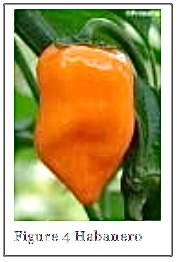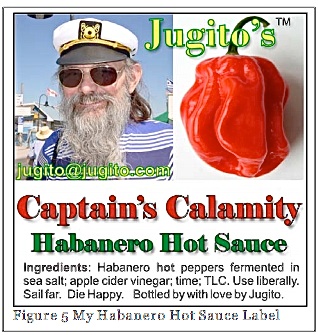Jugito’s Habanero Pepper Mash and Hot Sauce
Copyright © by Bob Hurt, 26 October 2006. All rights reserved.

The above photo shows habanero hot peppers I picked from 4 bushes I grew near my home. So far I have picked about 12 pounds this year.
Habanero?

I like my particular strain of habaneros which I believe came from the “Red Savina®.” I grew the plants from seeds I took from peppers I bought from a large fresh food market on Westheimer in Houston, Texas a few years ago, so I have no certainty about their true genetic strain.
Habanero Heat Versus Taste
I won’t get into scoville units and other ways of measuring pepper heat. I shall simply say that my habanero mash tastes and feels extremely hot, so much so that many people will not enjoy the taste experience.
I believe people let the heat come first in hot sauce bragging contests, partly because of the fun of showing macho toughness not only to tolerate the heat, but also to pretend enjoying it. As with any kind of torture, a person can get used to it and even crave it.
For example, I do have a friend to whom I give whole bottles of pepper mash, and he claims to use it liberally as one would sauce. But he still has the jar left after several months, so maybe he has a hard time walking the talk.

Most people do not realize what an absolutely delicious flavor the habanero peppers have. The heat overwhelms the taste. The heat limits the amount of habanero hot sauce people use, and so they seldom get enough to enjoy the intense and palate-pleasing taste. The University of Texas has produced a lower heat hybrid habanero that will change this when it appears on the market.

As a routine of life, I think it make no sense to ruin the taste experience with an overwhelming focus on heat. So, when I make mash, I sometimes remove the veins with the seeds to reduce the heat a little.
I have pulverized in my Vita Mix lots of veins and seeds after drying them, and created a terribly hot pepper powder that challenges the palate when added to any pizza, salad, or other dish. I believe the most intense heat
lies in the veins or ribs that connect the seeds to the pod.
Habenero Pepper Mash
“Pepper Mash” means mashed or pureed peppers that have fermented. “Fermented” means the peppers contain lactobacillus bacteria that ate the peppers and produced acetic acid and carbon dioxide gas. The fermenting process mellows the harsh rawness of aroma and flavor. It improves the taste without diminishing the natural sensation of heat the pepper capsacin imposes on your mouth, hands, and if you don’t show sufficient care, to other parts of your body. One pound of peppers produces one pint of mash. I make pepper mash in this way. I remove the seeds and puree the peppers in my Vita Mix with 6% by weight of sea salt for about 30 seconds. Then I let it sit to ferment in the jar as shown. Typically, I add pepper puree to the existing fermenting mash each week or so when a harvest cycle ripens to the beautiful red color you see. The new mash ferments in about 10 days if I use existing fermented mash as "starter." When the jar gets full, I set aside some mash as starter for the next batch of peppers, and refrigerate the rest for the aging process.
During fermentation, the solids rise to the top and the liquid sinks to the bottom. The solids rise because they trap the carbon dioxide gas byproduct of fermentation. After fermentation has finished completely, the bacteria no longer produce the carbon dioxide, so if you stir the mash to remove the bubbles, the solids will then sink to the bottom because they have higher mass than water.
Aging the Pepper Mash for Flavor
As with most fermented products, aging enhances the delicious aroma and taste of the mash. I could age it for up to 3 years, but so far I haven’t because we sell or give it away too fast. After just 3 months of aging it really tastes mellow and wonderful. I have aged more than a gallon so far this year, and given away or sold at least half of it in the form of hot sauce.
I’d like to age some in a cask of oak or some other hard wood, possibly even a charred oak cask, to determine what kind of flavor it imparts. Tobasco labels claim a 3-year aging, and frankly, I like my habanero sauce flavor much better than I like Tobasco. For years I didn’t even bother tasting other hot sauces because I figured they tasted like Tobasco. McIlheny ages Tobasco in wooden barrels, so maybe I should forget the idea. I like my mash and sauce just the way they are – aged in glass jars.
Why and How I Make Habanero Hot Sauce
After aging my habanero pepper mash I make it into hot sauce for several reasons: it reduces the heat, enhances the flavor for many kinds of foods, helps preserve it, and makes it healthier.
To make the sauce from a quart of mash, I mix in three teaspoons of xanthum gum powder to a pint of mash with my wand, then stir that into the quart inside a half gallon jar like the one shown. The gum has a starchy nature and no discernible taste. It acts as a thickener that keeps the solid and liquid from separating. Without it, the solids, after complete fermentation will sink, and the liquid will separate and rise to the top. To finish the sauce, I fill the jar with Bragg’s apple cider vinegar and shake it well. That makes a fairly thick but still somewhat loose pepper sauce. I do not add garlic or any other ingredient (yet).

Hot sauce enhances one’s health by dilating the capillaries and improving blood and oxygen flow to surrounding tissue. The capsacin can stanch bleeding. When you add the sauce to water, it can bring a person out of shock. The apple cider vinegar in the sauce improves the alkalinity of the body. And it makes one feel better because it tastes good.
Packaging

If you ignore the growing, harvesting, and processing time, the out of pocket cost comes to about $5 per quart of vinegar, $.10 for the sea salt, and $10 for the bottles, caps, seals, and printing, or about $15 for 9 bottles, $1.67 per bottle. I spend about 3 hours on the whole thing. Figuring $9 per hour, labor cost comes to $3 per bottle. So, I figure the minimum value of a bottle of hot sauce comes to around $5. I would add another $1 if I packaged each bottle in a fancy printed box.
I like to sell manufactured products to a niche market for 5X the cost in order not only to break even and profit, but also to afford a weekend vacation now and then. I should therefore sell the gourmet habanero hot sauce for $30 per bottle. Besides, I value my labor at more than $9 per hour, even when removing stems and seeds from habaneros while relaxing in my easy chair in front of a good submarine movie. I might need the fancy box for such a price, but with the power of direct marketing, maybe I should just spend the money on a killer web page and click-through ads, or send out an article like this from time to time.
Summary and Conclusion
I love the idea of growing the most flavorful and among the hottest of all peppers – red habaneros. I find the color delightful and enticing. I like making it undergo the fermentation changes with the bacteria that naturally lives in them. I like making the hot sauce and bottling it with my own label. And most of all I like the taste, the heat, and the fact that so many of my friends and acquaintances like it enough to pay me for it.
I find the work easy but challenging, and the process fun. If you want to know more or purchase some of my hot sauce, use the contact information below.
enough
Bob recently posted the following satirical ad on the internet.

enough
.
.
.
.
.
.
.
.
.
.
.





